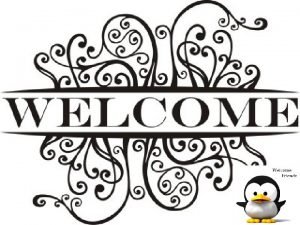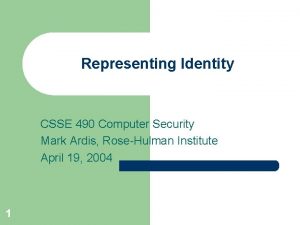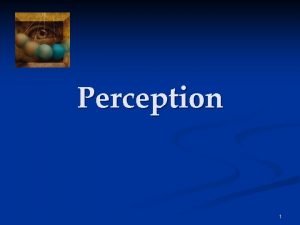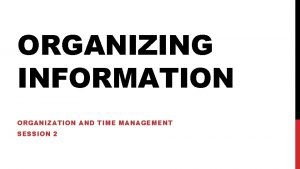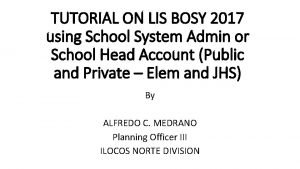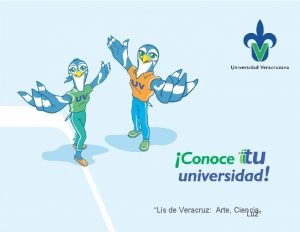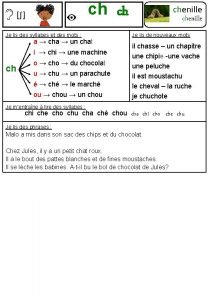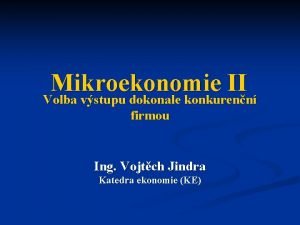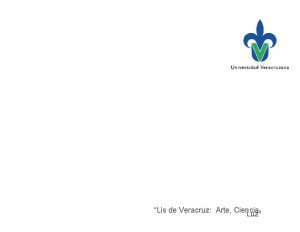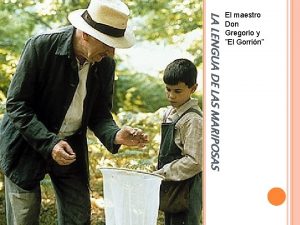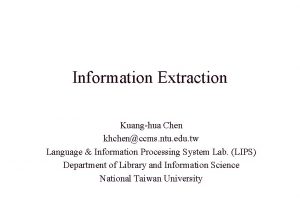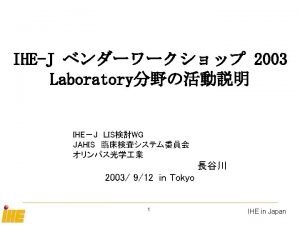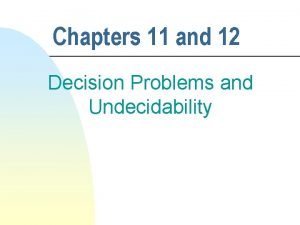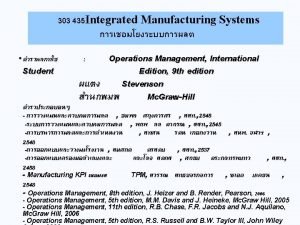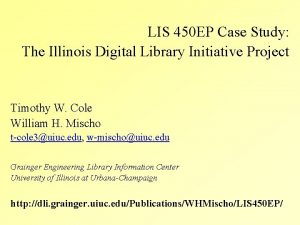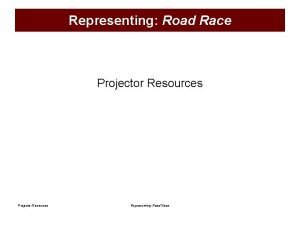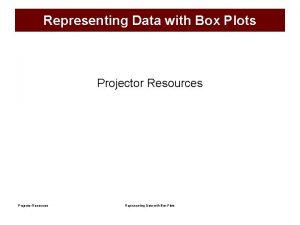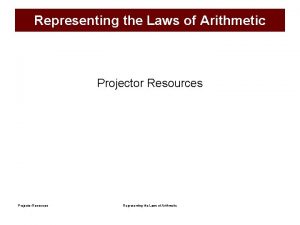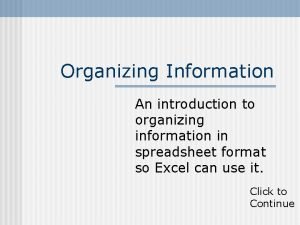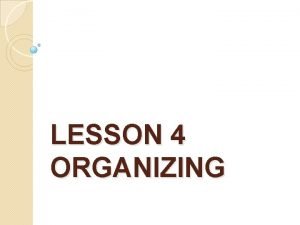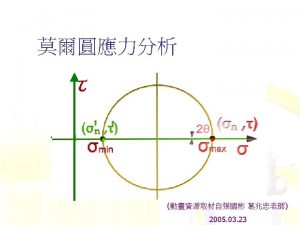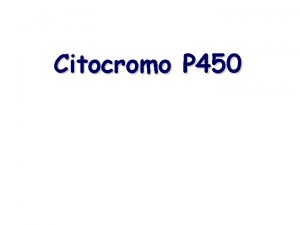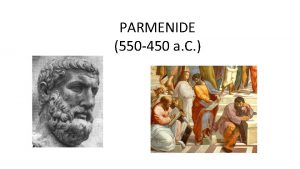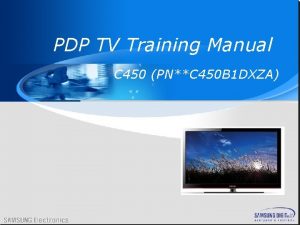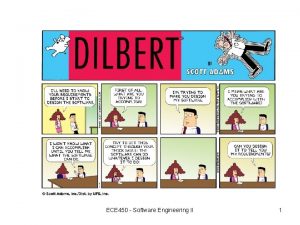LIS 450 RO Representing Organizing Information Resources Digital















- Slides: 15

LIS 450 RO Representing & Organizing Information Resources Digital Libraries, Metadata, & Interoperability Timothy W. Cole (t-cole 3@uiuc. edu) Mathematics Librarian 20 September 2001 http: //dli. grainger. uiuc. edu/Publications/TWCole/LIS 450 RO/

Working Definition of a Digital Library • A Functional Description: Integration of digital collections and associated support services that enable the organizing, locating, retrieving, and rendering of content from those collections.

Framework for DL Developers • Prepared by IMLS Digital Library Forum – Emphasis on Digitization Projects as Collection Components of Digital Libraries • Describes Four Components of Digitization Projects: – – Collections Digital Objects (Digitization Process Itself) Metadata Project Management

Digital Collection Principals • A Good Collection is Created According to an Explicit, Documented Collection Development Policy • Collection-Level Metadata Should Describe: Scope, Format, Access Restrictions, Ownership, and Information Establishing Authenticity, Integrity • A Good Collection Should Be Sustainable Over Time • A Good Collection Should Be Available & Accessible • A Good Collection Respects Intellectual Property Rights • A Good Collection Provides Some Measurement of Use • A Good Collection Fits in Larger Context of Significant National and International Digital Library Initiatives

Digital Object Principals • A Good Digital Object Is Digitized in a Manner That Supports Collection Objectives and Current & Likely Future Use • A good Object Is Persistent & Has a Persistent, Unique Identifier Conforming to a Well-Documented Scheme • A Good Object Can Be Authenticated • A Good Object Will Have & Be Associated with Metadata

Digital Metadata Principals • Good Metadata Appropriate to Collection, Users, and Current & Future Use • Good Metadata Supports Interoperability • Good Metadata Uses Standard Controlled Vocabularies to Reflect the What, Where, When and Who of the content • Good Metadata Includes a Clear Statement on the Conditions & Terms of Use for the Digital Object • Good Metadata Records Are Good Objects • Good Metadata Supports the Long Term Management of Objects in Collections

Illinois D-Lib Testbed • American Institute of Physics--APL, JAP, RSI – 16, 000+ articles, 1995 --. • American Physical Society--PRL – 10, 000+ articles, 1995 --, weekly updates. • ASCE Journals (25 titles) – 9, 000+ articles, 1995 --. • IEE Proceedings and Electronics Letters – 8, 500+ articles, 1993 --. • ASM (American Society for Materials) Handbook. • ACM (Association for Computing Machinery). • Elsevier Science.

Testbed Project Issues • Evolution of the Document. • Distributed Information Environment. • Use of Metalanguages & Transformations (SGML, XML). • Searching over Full-Text of Journals vs. Abstract & Index Service Database. • Rendering and Styling (SGML, XML, Math. ML). • Dynamic Metadata for Normalization, Linking. • Breadth and Depth of Collections.

Testbed Project Accomplishments • Process & Retrieve from Multiple Publishers & Heterogeneous DTDs. • Cross-Repository Searching. • SGML to XML Conversion. • Metadata Extraction, Representation, Merging. • Transformation & Rendering Technologies. • Dynamic Linking: Forward/Backward, from/to A & I Services.

Document Representation Issues • Articles Encoded in XML (Various Schemas) – Vendor-Neutral, Platform-Independent Standard – Fine-Grained Markup of Intellectual Structure – Transformable & Extensible (Metalanguage) – More Web & Application “Friendly” than SGML • Articles Broken into Components for Storage – As-Published Text (static) – As-Published Figures & Tables (static) – Metadata (dynamic) • links parts, references, related, alternate, value-added

Architecture Issues • Distributed, Modular Repositories – Distributed Document Storage (e. g. , by Publisher) – Separates Document, Metadata, Index, Gateway – Assumes Distributed, Standards-Based Clients • Implementation Issues – Multiple Views & Resource Combinations – Cross-Repository Searching: Harvesting Vs. Federation – Pre & Post-Coordinated Transformations


Search & Retrieval • Depth vs. Breadth – Exploit Unique Markup Schema to Search Homogeneous Collection with Fine-Granularity – Transform Metadata to Common Semantics to Search Across Heterogeneous Repositories • Search Enhancements – Normalization & Value-Added Content – Noun Phrase Co-Occurrence – Searching for Mathematics, etc.

Approaches to Metadata • Models of Metadata: – Administrative (Context) – Descriptive (Content) – Structural (Structure) • Dublin Core, Dublin Core Qualified • RDF – Statements & Reification – Towards a “Semantic Web” • METS (http: //www. diglib. org/standards/stamdframe. htm) • http: //www. getty. edu/research/institute/standards/intrometadata

Metadata and DL Interoperability • Models of Interoperability: – Gathering – Harvesting – Federation / Simultaneous Search • Links: – http: //dli. grainger. uiuc. edu/Publications/Meta. Data. Case. Study/ – http: //oai. grainger. uiuc. edu/
 Gambar trigonometri
Gambar trigonometri Csse certification
Csse certification Selecting organizing and interpreting information
Selecting organizing and interpreting information Organize information example
Organize information example The transformation process
The transformation process Fixed resources definition
Fixed resources definition Renewable resources vs nonrenewable resources
Renewable resources vs nonrenewable resources Lis dep
Lis dep Lis de veracruz
Lis de veracruz Je lis des syllabes
Je lis des syllabes Křivka lis
Křivka lis Lis de veracruz arte ciencia luz
Lis de veracruz arte ciencia luz Carmiña la lengua de las mariposas
Carmiña la lengua de las mariposas Ntu lis
Ntu lis Adt cus
Adt cus Land-l are recursive enumerable then lis
Land-l are recursive enumerable then lis
